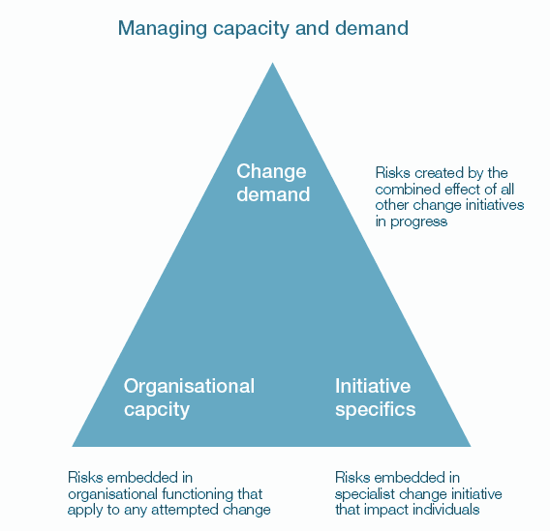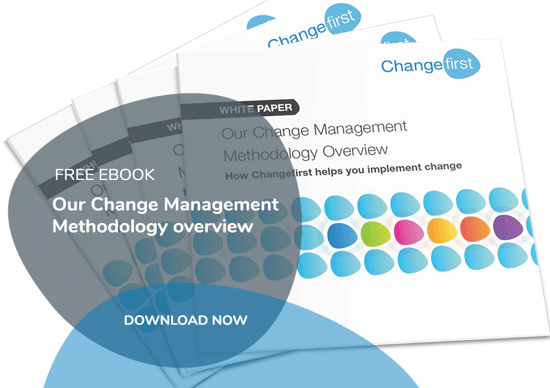For organisations to realise the full benefits of change, they must focus on managing people’s behaviour, skills and commitment to deliver successful implementation - and that must be led by people inside the organisation.
Major change only takes place when people shift their values, aspirations, skills and behaviours. When people stay in a particular situation for a period of time they usually develop established ways of thinking, feeling and behaving which are disrupted by the onslaught of major change.

Effective change management provides the process, tools and techniques to manage the people aspect of change - to achieve the most successful business outcome. It overcomes resistance and builds the necessary commitment in people that enables them to be ready, willing and able to change.
To manage employees’ transition from resistance to commitment, the change needs to be internally led. Employees require a lot of information, training, support, involvement and appropriate rewards, to feel valued, more in control of their destiny and committed enough to engage fully with change.
 |
Implementation of major change is only possible if change is visibly and energetically led by people inside the organisation. |
Managing capacity and demand
A major reason changes fail in organisations is that people feel overwhelmed by the sheer volume and speed of change initiatives impacting them. This often leaves people stressed, but at a minimum leaves them with little capacity to digest key organisational initiatives. If an organisation is to manage change effectively it must ensure that people have sufficient change capacity to be able to implement the really critical strategic changes.
Change capacity is a combination of people-based factors that affect the organisation’s ability to adapt. These include such building blocks as change legacy, implementation capability, personal adaptability levels and change leadership style. The greater the capacity to change, the more able the organisation will be to implement transformational change and/or to simultaneously implement multiple change projects.
Leaders must rigorously manage total change demand—measuring, understanding and controlling the number, speed and complexity of all changes in the pipeline. They must also evaluate the extent to which people are coping with the current change demands being placed on them. To implement a portfolio of major changes successfully, leaders need to monitor and manage all three risk components: the overall demand for change, the organisation’s capacity to implement that change and the specific risks of an individual change initiative within that context.
A balanced relationship which stretches the organisation without overwhelming the finite capacity for change is critical to overall implementation success. If the business operates with demand exceeding capacity for long periods people will become overwhelmed—stress levels will undermine morale, productivity and quality, overall capacity will actually decrease and leadership credibility will be questioned.

Benefits of a flexible methodology
Planning and executing the people and organisational aspects of change initiatives with a flexible methodology and supporting assessment and monitoring tool-kit helps to guide priorities, decision making and performance management.
When faced with business-critical change projects with a high cost and/or risk of failure, organisations often rely heavily on external consultancy support. However, implementation of this type of change is only possible if the initiative is visibly led by people inside the organisation. As the scale, frequency and importance of change increases, internal leadership and control become critical for corporate adaptability.
Employing a comprehensive, disciplined and systematic approach can significantly improve success rates. The methodology helps to maximise learning, build internal capability and increase overall organisational capacity while delivering the benefits from individual changes. This clear framework allows organisations to analyse and anticipate risks and enablers, while providing a motivating sense of control, clarity and belief that change is being effectively managed.
Using an effective change management process methodology, with supporting assessment and monitoring tools, enables leaders to:
- Assemble accurate, unbiased, timely information to guide decisions and ensure focus on the right issues, with the right people at the right time, in the right sequence. Constant awareness and adjustment is critical; plan must be flexible enough to respond to the dynamics of the change as they unfold.
- Evaluate the relative difficulty of changes in their portfolio and allocate resources accordingly, setting more realistic targets, schedules and budgets.
- Understand people’s issues, their capacity for change and their reactions to the change with the same clarity that one might expect to understand technical, logistical or financial issues.
- Make reality-based decisions using leading-edge measures—avoiding reliance on gut feelings, subjective feedback, conventional wisdom and myth that often lead to decisions which focus on the wrong change performance drivers.
- Measure change implementation progress in all areas of the organisation and understand where, when and how change efforts are working, where corrective action is required and on which areas to focus limited change management resources.
- Predict risk early using structured predictive change assessments - managing the issues likely to arise on a more proactive basis, rather than continually fighting fires. Instill a common language and mutual understanding which enhances individual, team and organisational learning and knowledge transfer.
- Provide regular feedback to drive accountability, maintain momentum, increase confidence and stimulate learning.
PCI is a structured approach to delivering change and specifically change projects that your change agents, executives, managers and employees can easily learn, adopt and apply, in order to deliver change successfully – at both an organisational and local level.
To learn more about PCI download our white paper – How PCI helps you implement change.



Leave a comment